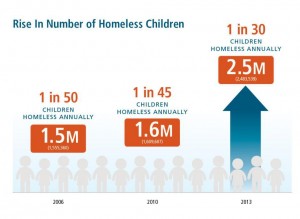A report on child homelessness, "America's Youngest Outcasts" published in November 2014, by the National Center on Family Homelessness at the American Institutes for Research identifies that 1 out of every 30 children in the US lived as a homeless child in 2013. This amounts to an 8 percent increase in child homelessness between 2012 and 2013. These children, 2.5 million in total, live in cars, on campgrounds, in shelters or in doubled-up arrangements with friends. Wherever they live, it is not a permanent and stable home.
The report identifies six major causes contributing to the rate of child homelessness: high poverty rates, lack of affordable housing, racial disparities, challenges of single parenting, domestic violence and other traumatic experiences, and the lingering effects of the recession. We know that children are resilient, but time to act is of the essence; early intervention is key to assure homelessness does not have a lasting impact. The effect homelessness may lead to serious mental health issues cause trauma for a child throughout his or her life. The lack of stable housing can interfere with learning and lead to poor cognitive skills and emotional distress.
 America's Youngest Outcasts," published November 17, 2014. The National Center on Family Homelessness at the American Institutes for Research
America's Youngest Outcasts," published November 17, 2014. The National Center on Family Homelessness at the American Institutes for Research
What remains shocking is the fact that children are homeless in every county and state across the country, in rural areas, towns, and major cities. The report identified that a majority of the homeless families consisted of a young single mother with two children, usually under the age of 6. The report scores states on the extent of child homelessness, well-being, risk, state policy and planning efforts. California, Alabama, and Mississippi scored at the bottom in the report’s ranking of states while Minnesota, Nebraska and Massachusetts topped the list at the other end of the spectrum.
The report offers suggestions to solve child homelessness through financial and mental health support for single mothers, investment in safe affordable housing, along with education and employment opportunities. The Homeless Children and Youth Act is waiting for a vote in both the House and the Senate, though waiting for the new 2015 Congress. The US government has set a goal to end homelessness by 2020 and end veteran homelessness by 2015.
Solving the problem of homelessness requires reforms that attack poverty in its infancy.



